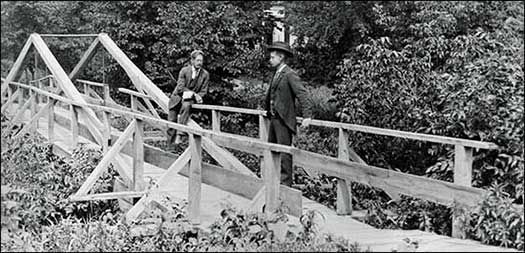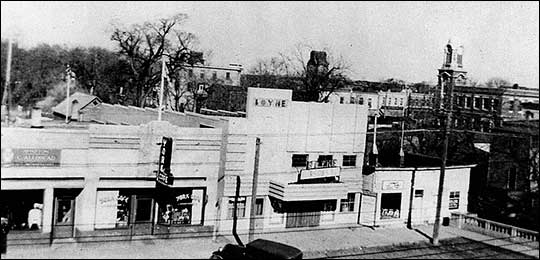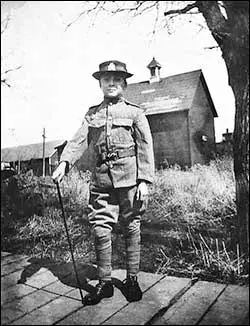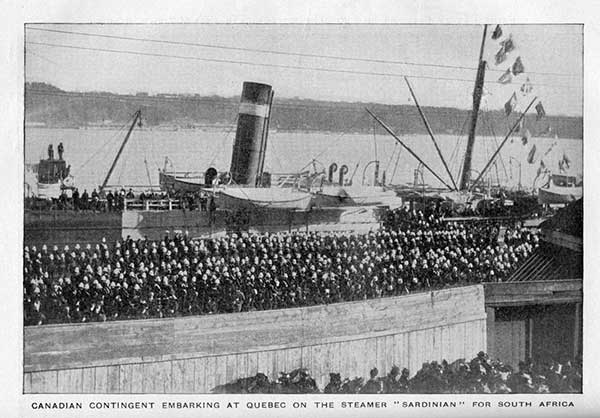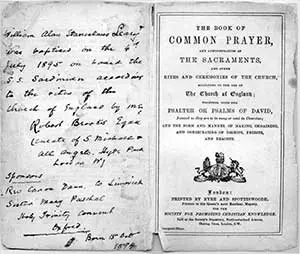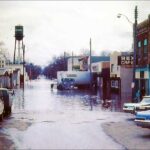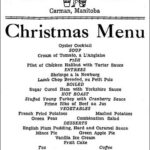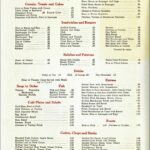Both the CDMHAC and the Carman Dufferin Museum receive inquiries from the public seeking information about people, places and things in the Carman and area.
If you have information that may assist these individuals, please contact the CDMHAC at carmandufferinheritage@gmail.com or contact a board member.
Hammond Avenue Home
Robert Martin of Calgary is trying to locate a photo of the home where his grandparents lived in Carman. He wrote: “In 1916, when my Grandfather when to war, the family, Jessie and George Wilson and children, moved to Carman, to an address the Census indicates as 226 Hammond Avenue [street or family number]. Current town maps show the new street and avenue numbers and not their original names…. The family chose Carman because my Grandmother’s family resided there (or in the vicinity). My Grandmother was a Harrison (Jessie Caroline), [sister of] John Harrison… “ The search is on; does anyone have information that would help Robert Martin locate a picture of the house?
Website Feedback: Olive Bowes on Changes in Carman
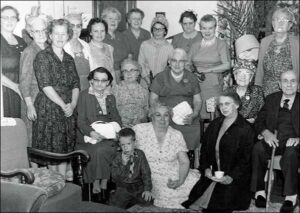
Olive Bowes, Carman teacher 1928–1969, is seated in the middle, front row. Does anyone know the other people in the group or the occasion of the gathering?
A number of items were forwarded to us by Eileen McIntyre, granddaughter of Dr. A. McGavin, who served the district from 1911 till his untimely death in 1948. With the collection was a letter written by Carman teacher Olive Bowes on July 4, 1969 to former students who were unable to attend her retirement reception in June of that year. Olive Bowes was born at Stephenfield in 1903 and taught in Carman for 41 years. Being a product of the prairies, she talks first about the weather and farming; she then describes some of the changes that occurred in Carman during her teaching years:
We have been having cool weather all spring. Our furnace has been on every day except four since January 1st. Lately we have been having very heavy rains. As a result much of the grain is standing in water. This is very serious as last year the farm crops received too much moisture. Then there was great difficulty in harvesting and later the work and cost of drying grain. Then there was little market for the grain.
As you all know the economy of Carman depends to a large extent upon the farmers. The landscape of Carman has also changed. The island has disappeared. The river now flows almost straight east from the Ryall Hotel to the former MacKenzie property. Highway No. 13 now runs directly north through the town and no longer circles the post office corner. I miss the island as I always thought it added to the beauty of the town. But for business purposes and travelling the new arrangement is much better.
Bridge over the Boyne River to ‘the island’The Bank of Montreal and the Bank of Commerce have built new attractive banks. The old Bank of Commerce has been moved to the property south of the “Old School”. This year I believe it is to be used as an open area classroom for three grade two classes. But in the future the basement is probably to be made into a banquet room. The first floor is to be used as lodge rooms and the third floor is to contain two suites.
The new Boyne Lodge is located on the west road just east of the railway track or just north of the trestle bridge. It provides a comfortable, happy home for some seventy senior citizens. In the north end is the Legion Lodge, which provides most comfortable living quarters for single older people, or married couples.
Carman’s project for Manitoba’s Centennial Year is a new library, which the committee hopes to have built on a convenient downtown location.
The co-op has built a lovely new store where you can purchase drugs, clothing, hardware, meats and groceries. There is also a co-op lunch-room where meals and lunches are served. The co-op also sells fuel oil, fuel for engines, lumber and custom-made buildings.
There is a laundromat and there are two dry-cleaning establishments.
The water from the Boyne is filtered and purified and so is now used in almost all the homes. Wells have almost all disappeared. Little houses behind big houses are also a thing of the past. No longer do the police call at the school on Nov. 1st and take out a group of students to put up what they knocked down the night before because they have almost all disappeared.
The Carman memorial Hospital is very attractive and provides for forty patients. The hospital is serviced by two local men—Dr. Ken Cunningham and Dr. Clinton North—and a newcomer, Dr. Regehr. The hospital also provides ambulance service.
There are many lovely new homes scattered throughout all parts of the town and whole new streets of houses have been built on the eastern side of the town.The golf course is absolutely beautiful and boasts an attractive club house.
At certain times of the year the Ryall Hotel and the Carman Hotel have rustic beer gardens located on their premises. The Boyne Theatre is not nearly as well patronized as it used to be but perhaps this is due to the varied television programs. Good eating places are prevalent in town. Syl’s Drive-In, Co-op Lunch Counter, Fireside Inn, Ed’s Service Station, Campbell’s Lunch Counter, Ryall Hotel dining room, Rex Café and the York Café all provide nourishing meals. The B.C. Café opposite the post office has disappeared.
Remember the Boyne Theatre and the York Café next door?
Potatoes, carrots, and sugar beets are now produced in very large quantities. Aubin’s nursery produces fruit trees, shrubs, perennial flowers, etc. for an ever-increasing market. Mr. Hunt also has a small nursery. Vanderveen’s and Vandersluis’s have very large greenhouses where bedding plants are grown.
Riding horses are very popular and many young people are the proud owners of beautiful horses which they board on the neighbouring farms.
The collegiate is located on the eastern edge of the town and has ample space for outdoor sports. The elementary school located on the grounds where the old school was now has grades I to VIII located in it. But a large school building program is planned. Many rooms and a new auditorium are to be added to the collegiate and then the grades VII and VIII will be moved to the collegiate. New classrooms are also to be added to the elementary school. When I first taught in Carman, there were only eleven on the staff: now there are almost fifty on staff. Carman no longer has its own school board but the Midland Divisional Board has charge of all the schools in the area. Wingham, Elm Creek, Miami, Roseisle, Graysville, Sperling, Roland and Altamont are all under the Midland Board. Two of my former teachers live in Carman—Miss York and Mrs. Campbell.
The rink is now located in the park. The swimming pool run by the Kinsmen, is also in the park, which forms a beautiful setting for it.
Olive Bowes goes on to describe her June 29th retirement reception which was attended by over 800 guests. She also gives an outline of the program, gifts received and names of out-of-town attendees.
The letter provides a fascinating journey back in time and, even if the weather and the uncertainties of farming remain constant, other changes have continued to re-shape Carman in the forty-five years since Olive Bowes retired. The letter is now in the Dufferin Historical Museum, which also is the source of the above photos.
September 2020
Carman Cadets. Does anyone have information about the Carman Cadet Corps from the around 1916? We received a welcome cross-section of information recently from Bob Briggs, formerly of this area, now living in Victoria BC. Among the treasures he shared were photos of his Briggs/Haycock/Tucker relatives.
This photo of Thomas Haycock was taken around 1916. Bob Briggs asks if anyone has any information about the corps. So far we’ve drawn a blank, so we’d be grateful if you can help us.
Thomas Vincent Haycock
ca. 1916
November 2019
Website Queries. We’re always pleased to get inquiries for information about local people and events. Sometimes the persons inquiring give us more information than we provide. Such is the case with a recent email from John Burchill, Vice President of the Winnipeg Police Museum and Historical Society. He is writing a history of the Manitoba Provincial Police (MPP) and was looking for information on a Christian Hansen who served as Carman’s town constable from 1908-12 before joining the MPP. We quickly discovered that this is a part of our local heritage that is sadly lacking in local accounts. Kernighan lists the town constables whose names he recalls but neither he nor other local historians speak of the duties or other aspects of the position.
Early newspapers provide a bit more information. Monthly reports from the Town Council note that Hansen was selected from among 56 applicants for the post of town constable, at a salary of “ $1,000 and uniform a year, all fees to revert to the town.” (The Dufferin Leader, 1908-05-14, p.1). Hansen had served in the Boer War 1900–01 and was living in Galt, Ontario at the time he was hired in May, 1908. By the time the next edition of the weekly newspaper came out, Hansen had arrived in Carman to assume duties as town constable. Later that year, he was invited to join police from Winnipeg in investigating a store robbery in Roseisle. In January 1909, the Dufferin Leader reported that Hansen was appointed Chief of Police including duties of building inspector, sanitary inspector and chief of the fire brigade — at the same salary.
Constable Hansen served in the Boer War
from “War in South Africa between the British and the Boers”This is where John Burchill’s information was most helpful. He explained in part that “Town police had jurisdiction in town but could make arrests and other duties outside town on a fee for service basis. By giving local constables additional police powers to operate outside their town, it gave the province good coverage without having the unnecessary expense of salaried employees. They would only be paid on a fee for service basis so if they didn’t do anything, they didn’t get any money…. At the time Hansen came in 1908 there were only 12 full time provincial police officers…. Hansen’s salary was equal to the Provincial Police.” In this case where his contract stipulated that “all fees revert to the town”, he didn’t benefit personally from outside duties.
Our local genealogy sleuths also checked for background on Christian Hansen. Turns out that John Burchill is away ahead of us on that research. Besides the basic birth, marriage and death records, we’ve jointly learned that Christian Hansen served in the Boer War, received a land grant for service, and was a police constable in Galt, Ontario before coming to Carman. Like every good search, we are left at this point with a few more questions than when we started. Can anyone help us answer the following questions:
- Christian Hansen married a Margaret Kennedy in Ontario. Any possible connection to our early Kennedy settlers? Could this be how he heard of the position?
- The Memorial Hall wasn’t built until 1919. Where were municipal offices and the Town Constable’s office located in the early 1900s?
- Has anyone seen a photo of Christian Hansen — preferably in uniform?
- Any family stories about run-ins with the local constabulary?
No doubt other stories about local law enforcement will surface as we delve deeper into the local newspapers from that era. The problem with old newspapers is that there are always so many distracting snippets of local history in each edition that the search through four or more years of weekly papers is going to take a while. We promise to provide updates as we go on any interesting findings. Meanwhile, we’d love to hear from anyone who can provide further information about our local police services.
Footnote. In the above photo, we see the S.S. Sardinian of the Allan Steamship Line embarking from Canada, carrying soldiers like Christian Hansen to serve in the Boer War. In the days before airplanes, ships were the only way for new immigrants, soldiers and other passengers to cross the ocean.
We are always amazed at how many links or connections we find among seemingly unrelated bits of our history. At the moment we are trying to find out whether Constable Hansen’s wife, who was a Kennedy, might be related in some way to our early Kennedy settlers on the Boyne. And in the case of the S.S. Sardinian, it just happens that this was same the ship on which my father was baptized a few years before it made its voyage to South Africa.
In 1895, our family was travelling back to Canada from Ireland where my grandfather had just served a term as Dominion Land Agent. His task was to persuade potential Irish immigrants that there were no opportunities like those in Western Canada. A newspaper account noted that an Allan Steamship Line representative was at one of his presentations, no doubt from a business perspective. Our grandfather spoke from experience, having headed west from Ontario in 1874 and walked the Missouri Trail to Nelsonville where he and his brother laid claim to homestead lands. He later ended up in the Treasury Branch of the provincial government and must have made the case that he was the man to make the trip back to the old sod. My father was born while the family was in Ireland and he was baptized on the ship coming home. His middle name ‘Alan’ was in recognition of the steamship company.
Baptismal record signed on board the S.S. Sardinian July 4, 1895 [Leary family files]Just imagine the stories ships like the S.S. Sardinian could tell – of new births and baptisms, immigrants seeking a new life in new country, soldiers off to war and facing loss of life, as varied as the people who sailed the seas.
September 2019
Rex Café. Last month we told you about a request for information about the Rex Café that we received from the Gin Wah family in Vancouver. The family owned the restaurant in Carman before fire destroyed the building in late November, 1976. We’re pleased to report that Carman/Dufferin MHAC Secretary Debbie Nicolajsen hit the jackpot when a friend produced a copy of a menu from the days when Gin Wah was proprietor. How many of you recall the days when you could get “Dinner for Six” for $10?
Debbie also located a couple of photos of Fournier St. SW, taken around 1970. The Rex Café sign shows the location of the restaurant on the ground floor of the old Sons of England building. On this occasion, the street is under water from the periodic flooding that Mother Nature bestowed upon Carman in the years before the Boyne River Diversion was constructed.
November 2015
Early Health Care. Our second e-mail communication was from a contact who was searching for her great-grandfather‘s grave. Francis “Frank” Jessop was one of the early, pre-1885 settlers in the Almassippi district north-west of present-day Carman. His obituary, which we located in The Carman Standard for July 24, 1894 (online through Pembina Manitou Archive), confirms the family’s understanding that he was buried in Carman Cemetery. Unfortunately, the grave doesn’t have a headstone nor does it appear on cemetery records. It’s been long suspected that the cemetery has early unmarked graves; now we know that this is likely the case, but we still have no clues to the exact location(s).
The obituary is of interest as well for the insight it provides into the life of our early settlers. Frank Jessop is described as a man “much liked by his neighbours for his kindly and generous nature” who had served as councillor in the Elm River area. When he came west in1881, his family remained in Ontario. Other families have reported finding the winters and living conditions too harsh to bring women and children west. Jessop’s farm was in an area known as locally as “Scrubtown”. The Dufferin history book (p. 38) describes it as an area with “heavy brush and a lot of scrub to be cleared”, other areas being “low and swampy”. Apparently the conditions affected Frank Jessop’s health and he was said to have been “suffering for three years from complications of diseases brought on by exposure when living on his own farm.” Since fall of the previous year, he had been unable to leave his house and for two months was confined to bed and cared for in the Peter Robertson home. Mrs. Robertson is credited with providing “unceasing care” and doing “all in human power could do to make his last days easier”, though he suffered from continual pain.
Stories like this provide some insight into the tremendous need for doctors, nurses and hospital care in settlements that were rapidly growing up across Manitoba. That is why the work of Eileen McGavin McIntyre’s grandfather, Dr. McGavin, and others like him still hold a special place in the histories of our community.
January 2014
Dr. A. McGavin
One of the first emails we received in response to our new website was from Eileen McGavin McIntyre, granddaughter of Dr. Andrew McGavin who practiced in Carman from 1911 until his death in 1948 while on call to the scene of an accident.

She also sent a poem her grandfather wrote about curling in Carman. The poem, titled Regarding “Fans” and Skips was written in February, 1936 and voices spectators’ views of the prowess of various skips and their teams. Dr. McGavin explains for the reader that “The “Fans” on the benches have all kinds of advice to give and one would think they knew the game better than anyone else. How often our forays into the past show us that some things never change!
Thanks to Eileen McIntyre for these and other anticipated gems from her collection. We are hoping to compile a booklet of Dr. McGavin’s poems about golfing, the hospital and other aspects of life in Carman. For more information on Dr. McGavin, see Memorable Manitobans: Andrew Edward McGavin (1876-1948).
Dr. McGavin in front of his office 1940.

